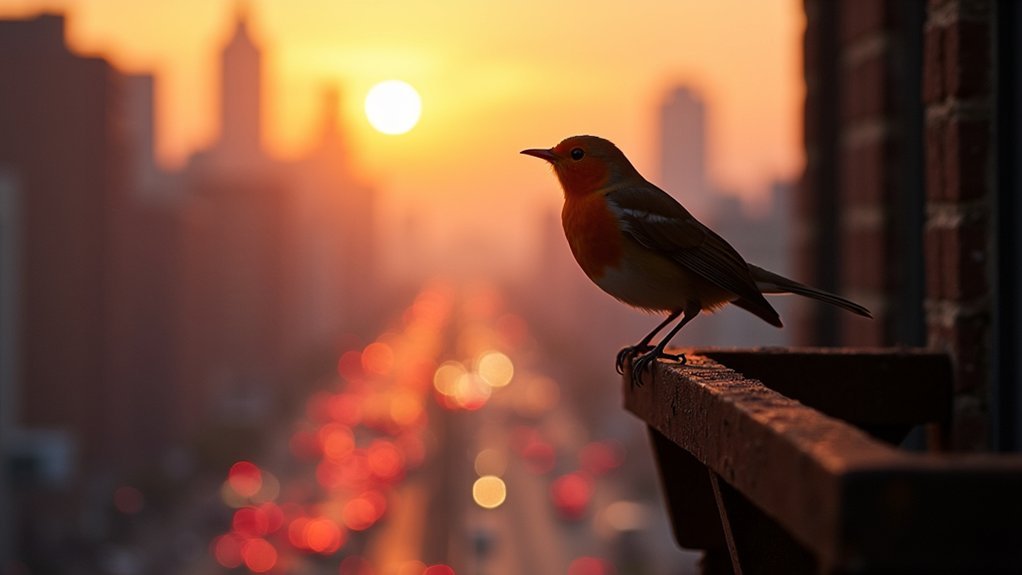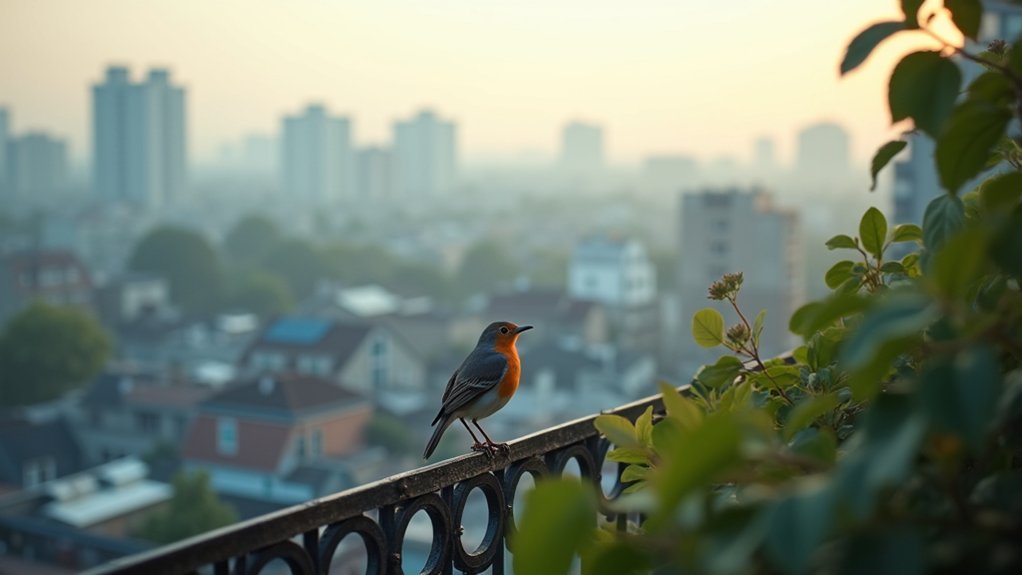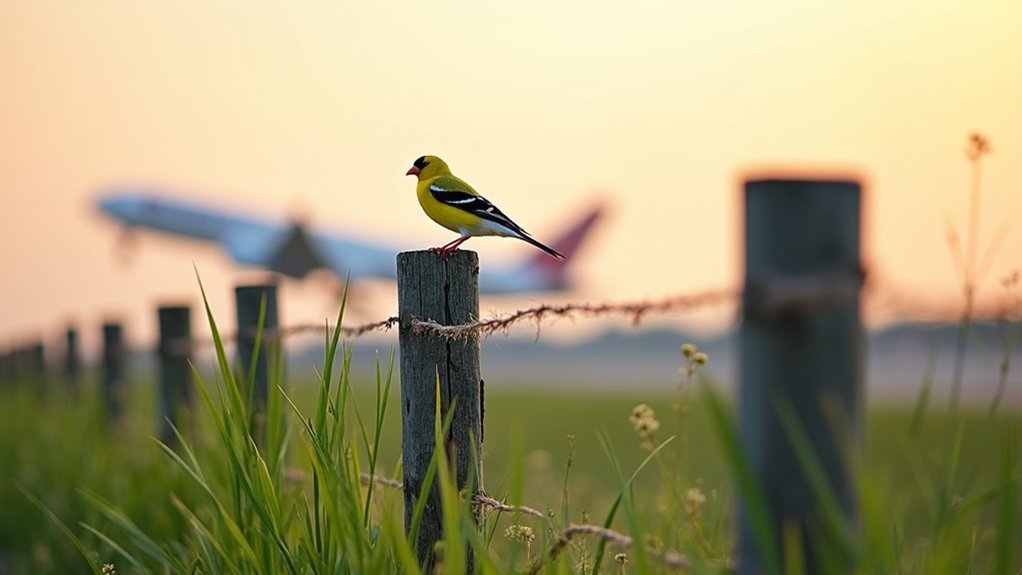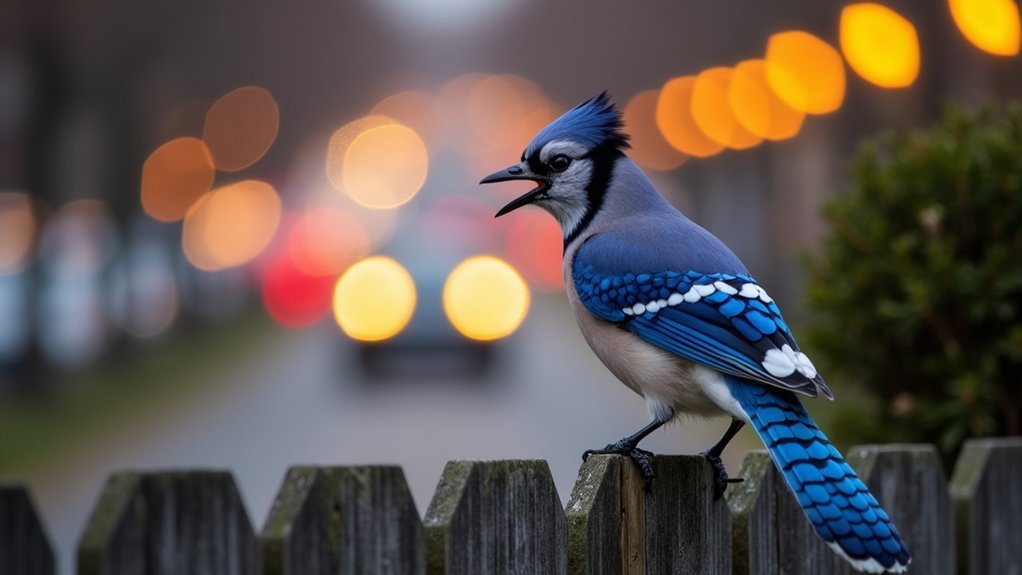Urban robins have dramatically altered their dawn chorus timing in cities, often singing as early as 3 AM compared to their rural counterparts who begin 30 minutes before sunrise. You’ll notice they sing before morning rush hour to avoid noise pollution, and some even perform at night. They’ve adapted by singing at higher pitches and louder volumes to cut through city noise, while maintaining smaller territories than rural robins. These fascinating adaptations reveal just how wildlife adjusts to our urban environments.
Dawn Chorus Timing: How Urban Robins Break Tradition

While their countryside cousins stick to traditional dawn performances, urban European robins have revolutionized their singing schedules to survive in concrete jungles. You’ll notice these urban birds starting their dawn chorus markedly earlier than their rural relatives, a direct response to the challenges of city living.
This timing shift isn’t random—it’s a calculated adaptation. By singing before the morning rush hour begins, robins avoid competing with peak noise pollution that would otherwise drown out their territorial messages.
Urban robins strategically sing before traffic noise peaks, securing acoustic territory in an increasingly loud world.
You’re witnessing evolution in real-time as these resourceful birds claim quieter acoustic spaces in the early morning or late evening.
Some robins have taken even more dramatic steps, abandoning daytime singing altogether for nocturnal performances when city sounds diminish, ensuring their songs travel effectively through the urban landscape.
Light Pollution’s Role in Robin Singing Patterns
As cities illuminate the night sky with their perpetual glow, light pollution emerges as the primary catalyst behind urban robins’ shifting vocal schedules.
You’ll notice these adaptable birds beginning their dawn chorus notably earlier in urban environments, their natural circadian rhythms disrupted by the artificial daylight from streetlights.
Research confirms that light pollution doesn’t just alter when robins sing—it transforms how they sing. Urban birds adjust their vocalization frequency and duration in response to enhanced nighttime visibility.
This disruption creates a desynchronized dawn chorus across city landscapes.
The consequences extend beyond timing shifts. In brightly lit urban environments, robins face increased competition for acoustic space, forcing adaptations in their mating strategies.
Their remarkable flexibility showcases how wildlife continuously evolves in response to our illuminated world.
Traffic Noise and the Shifting Songbird Schedule

You’ll notice urban robins singing at night, a remarkable adaptation to avoid the cacophony of daytime traffic noise that masks their songs.
This shift to nocturnal singing helps these resourceful birds communicate more effectively with one another, ensuring their messages aren’t lost in the urban soundtrack.
Traffic patterns have forced these songbirds to reschedule their performances, with many robins now vocally active outside traditional dawn chorus hours when vehicles dominate the soundscape.
Noise Alters Singing Times
Despite the cacophony of urban environments, European robins have developed a remarkable adaptation to city life.
You’ll notice these resilient birds have shifted their singing schedules to the night hours when traffic and human activity subside. Noise pollution affects their communication patterns so greatly that they’ve abandoned traditional daytime singing in favor of quieter nocturnal performances.
Research confirms it’s primarily the daytime noise—not light pollution—that drives this behavioral change.
Urban bird species are increasingly singing earlier in the morning and continuing well into the night to guarantee their territorial calls and mating songs are heard.
This strategic timing allows robins to maintain effective communication despite urban challenges, demonstrating their impressive adaptability to our noisy cities.
Adapting Through Nighttime Vocals
European robins have revolutionized their singing routines by embracing the night hours when traffic noise subsides. You’ll notice this remarkable adaptation in cities where urbanization on bird dawn patterns has shifted dramatically. Their increased vocal activity during nighttime singing demonstrates incredible behavioral flexibility in response to our noisy urban environments.
- Nighttime singing allows robins to communicate without competing with traffic noise
- Sound travels more effectively during quieter nighttime conditions
- Nocturnal vocals help males establish territory and attract potential mates
- This behavioral shift prioritizes acoustic effectiveness over traditional timing
- Research shows noise pollution impacts birds more notably than light pollution
This adaptive strategy enables robins to thrive despite challenging urban conditions.
Their ability to adjust their communication timing showcases how wildlife can evolve behaviors to overcome human-created obstacles, ensuring their messages are heard clearly in an increasingly noisy world.
Comparing Rural vs. Urban Robin Vocalizations
You’ll notice urban robins sing at higher pitches than their rural cousins, a clever adaptation that helps their melodies cut through city noise pollution.
Their timing patterns differ too, with city birds often performing at night or before dawn when human activity quiets down, while countryside robins stick to traditional daylight schedules.
These habitat-specific adaptations extend beyond just when they sing—urban birds may compress their vocal performances into shorter, more intense bursts during quiet periods, whereas rural robins can spread their songs more evenly throughout the day.
Pitch and Volume Differences
While maintaining their melodious charm, urban robins have developed distinct vocal adaptations that set them apart from their rural relatives.
You’ll notice these city dwellers have adjusted their songs to overcome the challenges of urban noise through remarkable changes in their vocalizations.
- Urban robins sing at higher pitch frequencies to stand out against background city sounds
- Their volume is noticeably louder to compensate for ambient noise pollution
- They’ve altered their singing schedule, often performing at night when cities are quieter
- City robins begin their dawn chorus earlier than their country counterparts
- The duration of their songs has adapted to maximize communication effectiveness
These adaptations demonstrate the robin’s impressive ability to modify their ancient vocal patterns when faced with modern acoustic challenges, ensuring their beautiful songs continue to be heard despite urban noise interference.
Timing Patterns Shift
As dawn breaks across different landscapes, the timing of robin songs reveals a fascinating urban adaptation story. In urban areas, you’ll notice robins singing much earlier than their country cousins, sometimes beginning their dawn chorus as early as 3 AM while rural robins start just 30 minutes before sunrise.
| Time Feature | Urban Robins | Rural Robins |
|---|---|---|
| Start Time | 3 AM | 30 min pre-sunrise |
| Primary Cause | Noise levels | Natural light |
| Night Singing | Common | Rare |
| Adaptation Type | Time-shifting | Traditional |
This timing shift isn’t primarily about light pollution—it’s a clever response to urban noise levels. By singing when cities are quietest, robins guarantee their communications aren’t drowned out. You’re witnessing a remarkable behavioral adaptation that allows these birds to thrive despite the acoustic challenges of city life.
Habitat-Specific Song Adaptations
The vocal repertoire of urban robins has evolved dramatically beyond mere timing shifts. You’ll notice urban birds adapting their singing behavior to thrive in noise-filled city environments, while their rural cousins maintain traditional patterns.
- Urban robins frequently shift to nighttime singing when ambient noise levels drop.
- City birds adjust song frequency to avoid overlapping with traffic sounds.
- Rural robins maintain consistent daytime singing patterns with traditional dawn chorus timing.
- Urban individuals demonstrate greater vocal plasticity in response to anthropogenic stressors.
- City dwellers modify both song complexity and output to maintain effective communication.
These adaptations showcase remarkable behavioral flexibility as robins navigate increasingly noisy urban landscapes.
Where rural robins follow evolutionary patterns established over millennia, their urban counterparts continuously adapt their vocal strategies to guarantee their messages carry through the cacophony of city life.
Adapting to the Concrete Jungle: Behavioral Changes
European robins living in urban environments have dramatically altered their singing behavior to survive in noisy city landscapes.
You’ll notice these adaptable birds now prefer singing at night rather than participating in traditional dawn choruses. This nocturnal singing time shift represents a remarkable example of behavioral plasticity in response to urban challenges.
While both noise and light pollution affect urban birds, research shows noise has the greater impact on their communication patterns.
Noise pollution outweighs light disruption as the primary factor reshaping how city birds communicate in urban settings.
By switching to nighttime vocalizations, robins effectively avoid competing with the cacophony of daytime city sounds that would otherwise drown out their territorial and mating calls.
This strategic adaptation guarantees these resilient birds maintain essential communication despite harsh urban soundscapes, demonstrating how wildlife can adjust to human-dominated environments when traditional behaviors become ineffective.
The Science Behind Early Morning Bird Songs

Dawn’s stillness creates the perfect acoustic theater for bird communication, explaining why so many species have evolved to sing during this period.
When you listen to the dawn chorus, you’re witnessing a scientific phenomenon shaped by both nature and urban pressures.
- Morning’s cooler temperatures and lower humidity allow bird calls to travel farther
- Urban noise pollution forces birds to start singing earlier, sometimes as early as 3 AM
- Singing patterns shift to avoid acoustic competition with traffic and human activities
- Moonlight and weather conditions (like cloud cover) directly influence chorus timing
- Sound propagation science explains why early morning provides ideal acoustic conditions
This adaptation demonstrates how wildlife continuously evolves singing patterns in response to our changing urban environments, creating new ecological relationships between humans and birds.
Seasonal Variations in Urban Robin Choruses
Throughout the year, urban robins adjust their vocal performances to match the rhythm of both natural seasons and city life.
You’ll notice their dawn chorus shifting dramatically from winter to spring, reaching peak intensity during late April and May when breeding activity is highest.
As temperatures rise in late March, these adaptable songsters begin singing about thirty minutes before sunrise, often earlier than their rural cousins to beat rising ambient noise levels from morning traffic.
During summer months, they’ve even adopted nocturnal singing habits to circumvent daytime urban clamor.
Watch for seasonal variations in both timing and duration—robins respond not only to temperature changes but also to moonlight intensity and the presence of other returning migrants.
Urban Robin Territories and Vocal Boundaries

You’ll notice urban robins maintain notably smaller territories than their rural counterparts, adapting their vocal boundaries to the confines of city blocks and green spaces.
Their songs change across different urban environments, with higher-pitched calls in downtown areas and more complex melodies in quieter residential neighborhoods.
Artificial lighting plays an essential role in reshaping these territories, as streetlamps and building illumination extend perceived daylight hours and create unusual territorial defense patterns.
Territorial Size Variations
While countryside robins enjoy expansive territories, their urban cousins make do with considerably smaller patches of land. You’ll notice these adaptations reflect their remarkable resilience in urban ecosystems. The shrinking territorial size directly responds to city life’s unique pressures.
- Urban robins defend territories up to 30% smaller than rural counterparts
- Males sing at higher frequencies to overcome anthropogenic noise
- Vocalizations increase during quieter periods to maximize communication
- Smaller territories require less energy to defend in dense populations
- Despite constraints, urban robins successfully attract mates and reproduce
This territorial downsizing demonstrates how robins strategically adapt to city living. Rather than abandoning urban areas, they’ve evolved behavioral modifications that allow them to thrive despite the challenges of compressed space and acoustic interference.
Song Adjustments Citywide
As city lights illuminate the urban landscape, European robins have dramatically altered their singing schedules to navigate the cacophony of human activity.
You’ll notice these adaptable birds singing at night rather than competing with daytime traffic noise, a direct response to urbanization.
Their song frequency has changed too—urban robins modify their vocalizations to guarantee effective acoustic communication despite the challenging city soundscape.
They’ve established new vocal boundaries, strategically positioning themselves where their songs carry best above background noise.
When you listen carefully, you’ll detect differences in duration and timing of their songs compared to their rural counterparts.
These adaptations aren’t random—they’re calculated adjustments that allow robins to maintain territorial claims and attract mates while city life roars around them.
Artificial Light Impact
Artificial light represents a powerful force reshaping urban robin territories. When you observe urban robins, you’ll notice their vocal boundaries shifting dramatically due to artificial light at night (ALAN). The earlier dawn chorus you hear in cities directly results from this light pollution disrupting the birds’ natural rhythms.
- Robins sing at night in cities to avoid competing with daytime urban noise
- ALAN triggers earlier singing start times, altering territorial boundaries
- Streetlights cause robins to sing more frequently, changing vocal output
- Light pollution extends singing periods beyond natural circadian patterns
- The combination of light and noise pollution creates unique urban territorial dynamics
This urbanization-driven phenomenon demonstrates how robins adapt their communication strategies to maintain effective territories despite the altered acoustic environment of our illuminated cities.
Acoustic Competition in City Environments

Since moving to urban centers, European robins have found themselves locked in a complex acoustic battle. You’ll notice these adaptable birds have shifted to nighttime singing to overcome the overwhelming daytime noise pollution from traffic and urban activities that frequently drowns out their calls.
As urbanization intensifies, robins must compete for increasingly scarce acoustic space. They’ve responded by raising their vocal pitch and volume while abandoning traditional dawn and dusk singing schedules.
This acoustic competition has meaningful consequences—it alters their territorial behaviors and mating success as they struggle to communicate effectively.
Research confirms that nighttime singing, though uncommon in rural settings, provides urban robins a strategic advantage, enabling them to establish territories and attract mates despite the challenging noise landscape of city environments.
Health Implications of Modified Singing Patterns
While urban robins have adapted remarkably to city soundscapes by shifting their singing to nighttime hours, these modified patterns come with significant health costs. You’ll find these nighttime singers face serious challenges beyond mere adaptation.
- Disrupted circadian rhythms compromise overall health and immune function
- Increased stress hormones from noise pollution weaken physical resilience
- Altered sleep cycles lead to chronic stress that affects survival rates
- Compromised mate attraction reduces reproductive success and genetic diversity
- Combined effects of noise and light pollution increase disease susceptibility
These health implications extend beyond individual birds to entire urban robin populations. When robins can’t maintain proper biological rhythms, their reproductive success plummets.
The trade-off for adapting to city life through nocturnal singing creates a cascade of physiological challenges that may ultimately threaten these beloved urban birds.
Recording and Identifying Urban Robin Songs
Although capturing the unique songs of urban robins presents distinct challenges, modern recording techniques have revolutionized how researchers document these adaptations. You’ll find that automatic recorders programmed for continuous 24-hour operation capture the full spectrum of singing activity, revealing how urbanization affects these birds’ vocal behaviors.
| Recording Period | Urban Robin Behavior | Key Characteristics |
|---|---|---|
| Night (11pm-3am) | Peak singing activity | Higher pitch, shorter phrases |
| Dawn (4am-7am) | Reduced chorus | Timing shifted earlier than rural |
| Day (8am-6pm) | Minimal singing | Occasional bursts between noise |
When identifying urban robin songs, you’ll notice they’ve adjusted their frequencies to avoid competing with city noise. Their strategic shift to nighttime singing demonstrates remarkable adaptability, allowing you to distinguish urban robins from their rural counterparts through both timing and tonal qualities.
Conservation Strategies for Urban Songbirds
Because urban environments continue to expand worldwide, protecting songbirds like robins has become increasingly essential for maintaining biodiversity in cities.
As cities grow, safeguarding robins and other songbirds becomes vital for preserving urban biodiversity.
You can help implement conservation strategies that address the challenges urban songbirds face:
- Create green spaces and urban gardens that serve as noise pollution buffers while providing habitat for robins
- Reduce artificial lighting in your neighborhood to help restore natural dawn chorus timing
- Support urban planning that incorporates sound-absorbing materials to improve acoustic communication
- Join community conservation efforts focused on protecting nesting areas from disturbance
- Participate in citizen science projects that monitor urban robin populations and vocal behaviors
These approaches not only benefit robin populations but also enhance your urban environment through improved soundscapes and increased biodiversity, making cities more livable for both humans and wildlife.
Frequently Asked Questions
Why Do Robins Sing so Early in the Morning?
You’ll hear robins singing early because they’re taking advantage of quiet conditions with less noise. They’re establishing territory, attracting mates, and benefiting from cooler temperatures that help their songs travel farther.
Where Do Birds Go at Night in the City?
You’ll find city birds roosting in trees, shrubs, building ledges, and sheltered nooks at night. They’re seeking protection from predators and weather while resting. Some species, like urban robins, might even be singing.
How Long in the Morning Can the Dawn Chorus Go On?
You’ll hear the dawn chorus starting 30 minutes before sunrise and continuing for several hours. It’s most intense during April-May breeding season, but weather, moonlight, and ambient noise can shorten or extend it.
Is the Dawn Chorus Seasonal?
Yes, the dawn chorus is definitely seasonal. You’ll hear it most prominently during spring breeding season (March to May), tapering off by late summer. In warmer climates, you’ll notice some year-round chorus activity.
In Summary
You’ve seen how city robins defy tradition, singing earlier to avoid traffic noise and adapting to artificial light. Their urban dawn chorus represents remarkable resilience in our concrete jungles. As you listen for these modified songs, remember they’re not just beautiful—they’re survival strategies. Your awareness of these adaptations can help support conservation efforts ensuring urban robins continue to brighten your mornings for generations to come.




Leave a Reply